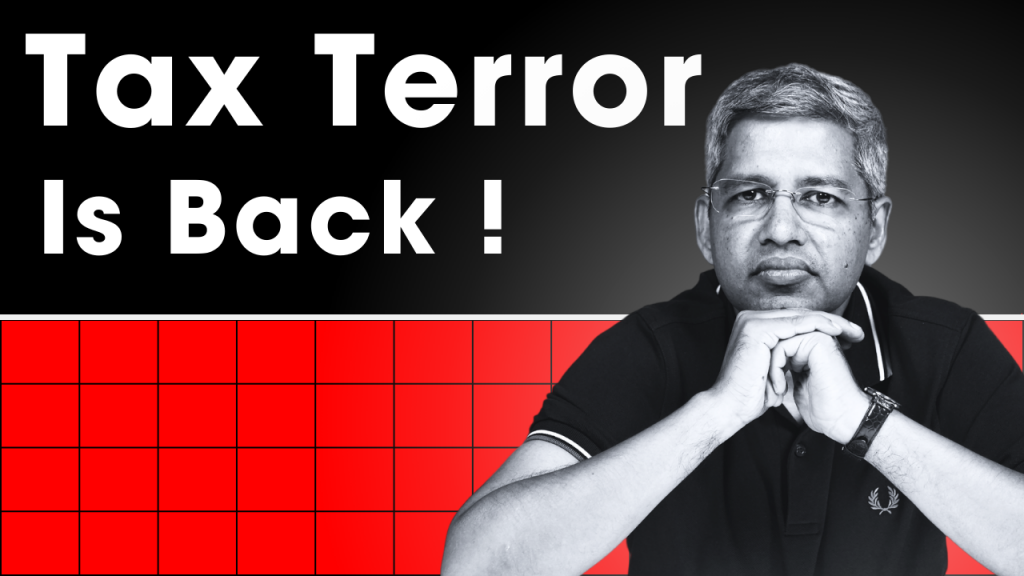
Today was important because we had the union budget. As I mentioned in yesterday’s video, I had expectations of some regressive additional taxes, and my worst fears came true today. Taxation on almost every front has been restructured, rejigged, and increased. Although in a year where we were boasting about very high direct tax collection, very high indirect tax collection, and very high RBI dividends to the government, there wasn’t much need for so much tinkering and increasing taxes, especially in the realm of capital gains. But whatever the government chooses, it can do, and we have to basically abide by it.
People seem to be not so happy. Yet the markets didn’t fall. The beauty of the Nifty right now is that, come what may, the index doesn’t fall. That is telling you that the market will brush this aside going forward. That’s the message the market is giving today.
When we discuss it in the second half, I would call it almost tax terrorism. For instance, in the case of STT, you first introduce STT saying that I’m introducing STT instead of long-term capital gain. Long-term capital gain is off, but STT will be there. That STT will be set off against your other tax commitments. If you paid, say, one lakh STT in a year and you had to pay a total of two lakhs of income tax, then one lakh is set off from there. That is where we started STT from. I don’t know how many of you will remember or experienced this; it was, I think, in 2004. Then the next step came that STT will remain where it is. We will not give you the setoff. Then the next step came, STT will remain, but we will increase it. That also people accepted. Then the next step came. The increased STT will remain, and we will have long-term capital gain also. That also people digested. Now the next step is that we will increase the long-term capital gains also. And we will increase STT also. Now more that is getting into the territory of not listening at all to at least the market participants. Just by giving some small doles to the middle class, you know, some 16,000-17,000 rupees will be additionally available for disposable income, is not a big deal. And the exemptions in the budget remain where they were.
So overall, it’s not a very enthusiastic budget announcement for the capital markets, but overall for India’s growth perspective, allocation to defense, allocation to railways, allocation to jobs and education, at least on paper, it looks good. From a very personal point of view, how it will impact each of us is maybe not so good. But if we see that overall, if the country is growing, we will grow along with it, then you can say, maybe not so bad either.
Market Overview
Where’s the market headed? The market made a very nice looking, I would say, long-legged candle today. At one point when it reached this previous support, it did seem like it would give up and stay down. But it recovered very dramatically. Nobody could have imagined, even with the set of taxations, increase in taxation, that this kind of end of the day would happen where Nifty has fully recovered from the bottom. If you recall the election day, there was recovery, but only to some extent. And here today, you are seeing that almost full recovery is happening, and we’ve closed just near yesterday’s close. No harm done.
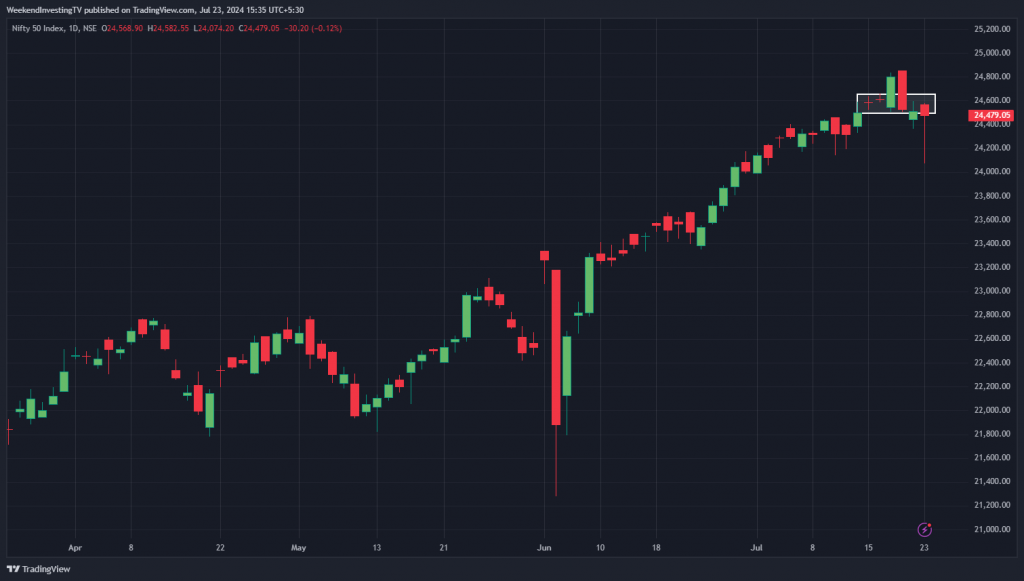
Nifty Next 50
Nifty Junior cracked very hard. Went from nearly 72,000 to 69,000, but again recovered very, very smartly to close above this moving average here at -0.8%. Some damage there for sure.
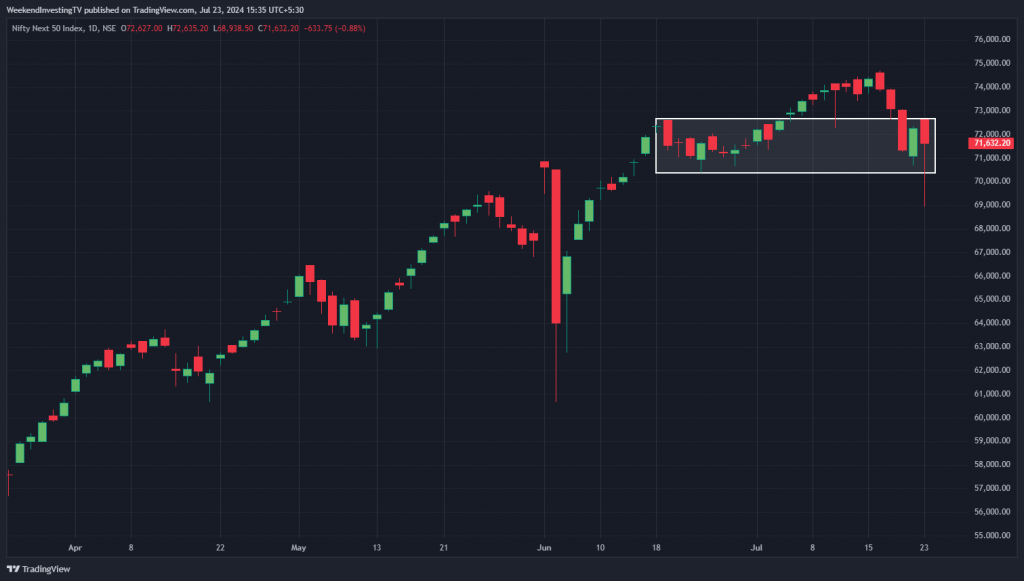
Nifty Mid and Small Cap
Mid caps also recovering very hard. Almost 700 points on the bottom at -0.44%, down still very much within yesterday’s close. And small caps also doing the same. In fact, small caps had reached 16,500, virtually where we were a few days after the election, and recovered back again. So this is -0.6% on that.
This is actually speaking. If you set aside the damage to your own bottom line because of taxation, to set that aside, this is a fantastic move in the market, signaling strength, signaling buying at every level, signaling that there is enough liquidity in the system to withstand some of these shocks. And that’s what happened today.
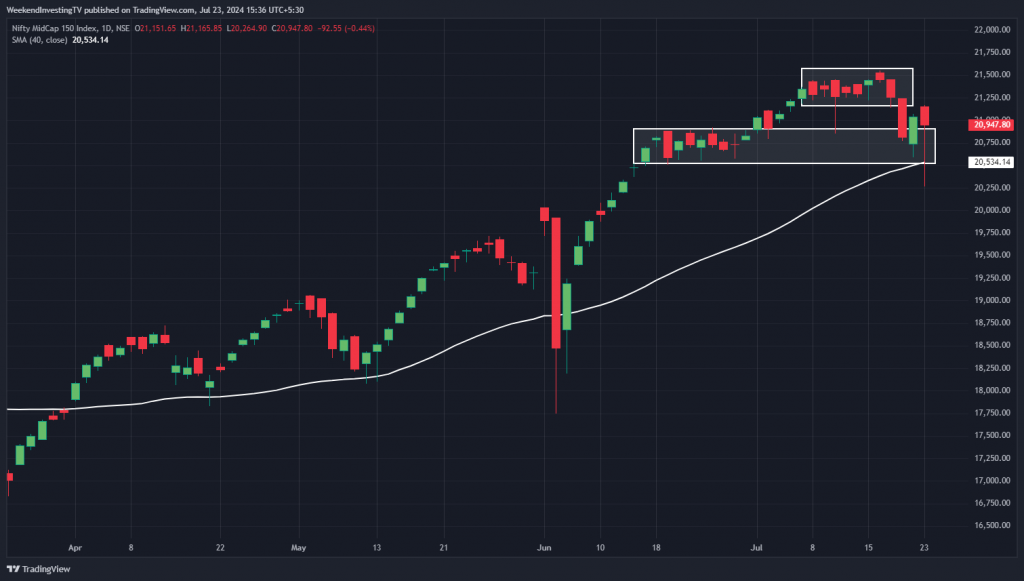
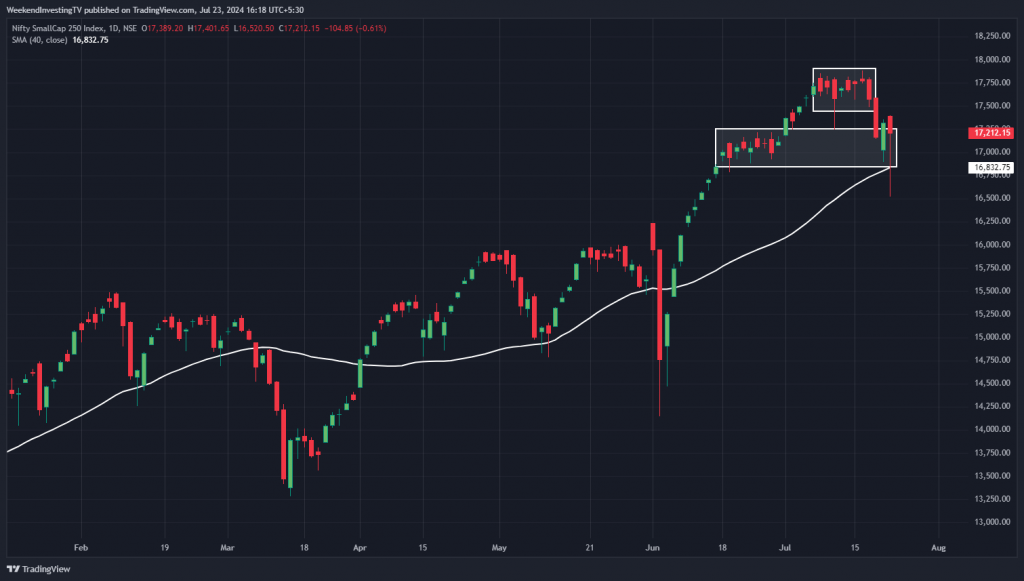
Nifty Bank Overview
Bank Nifty, however, slipped a bit, down 0.96%, closing at 51,778. But still, I would say below, if it remains above 51,165, I would remain hopeful that it will turn around sooner or later.
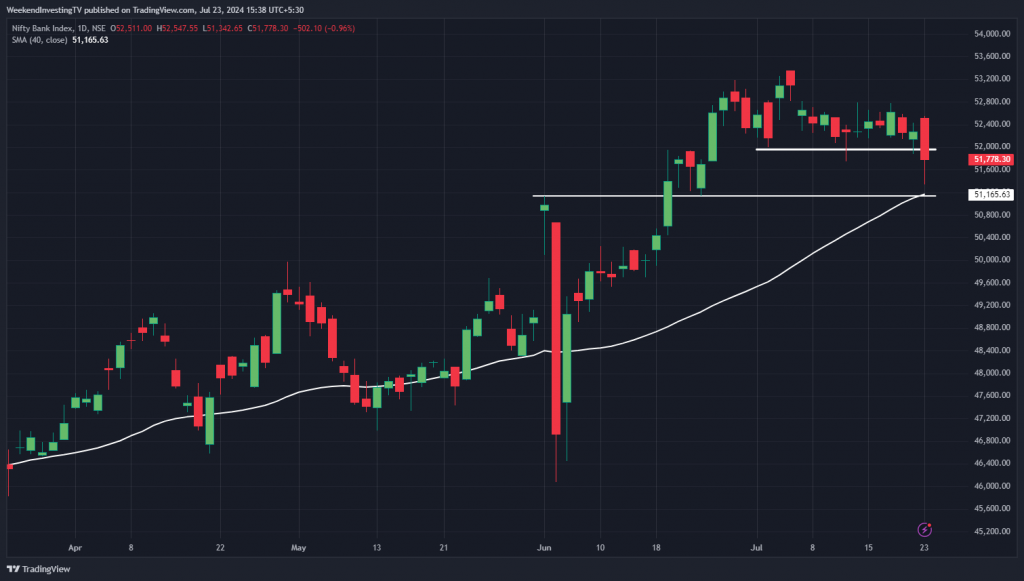
Nifty Heatmap
Looking at today’s heat maps, you can see that banking was down, Reliance down, L&T down, Power Grid, Asian Paints, ONGC, Coal India, Axis Bank, a lot of index heavyweights down. But on the other side, you had Infosys, TCS, HCL Tech moving up. You had ITC move up 5.5%. You had Titan move up 6.5% on reduced gold duties, NTPC up 2.4%. Adani Ports, Tata Consumers, Hindustan Levers, all of those were up. So it was a very well-balanced Nifty trade. Whether it was managed this way or it automatically happened this way, I have no idea. But it is surprising to see that people who, in general, were disappointed with especially the taxation part of the budget, the markets have stayed resilient.
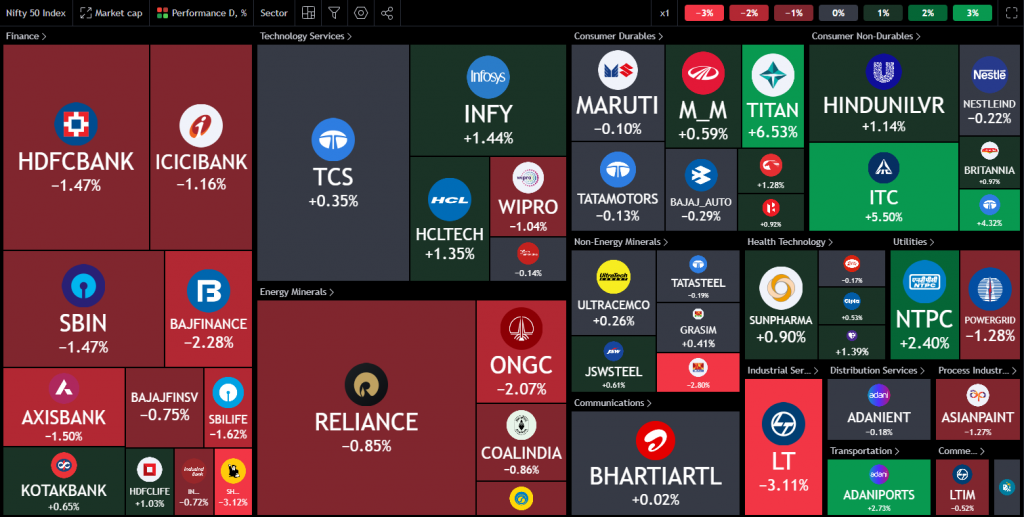
Also, Nifty Next 50 was more red, so you can see this entire left side. LIC, IRFC, all the rail stocks were badly damaged. I think rail stocks will make some sort of a comeback tomorrow because they have allocated some 2.3 odd lakh crores to railways. Much higher budgeting for railways, I’m not sure what was the expectation, but rail stocks had run up a lot before the budget hoping for more allocation. And I think that has come through. Stocks like HAL, BEL, PFC, REC, definitely down and maybe can go down further. There was no talk about disinvestment or those targets, or maybe I missed the same. So that is something that we need to watch out for. Torrent Pharma, Godrej CP, Dabur, United Spirits. These were some of the stocks that really held up for Nifty Next 50 sectoral trends.
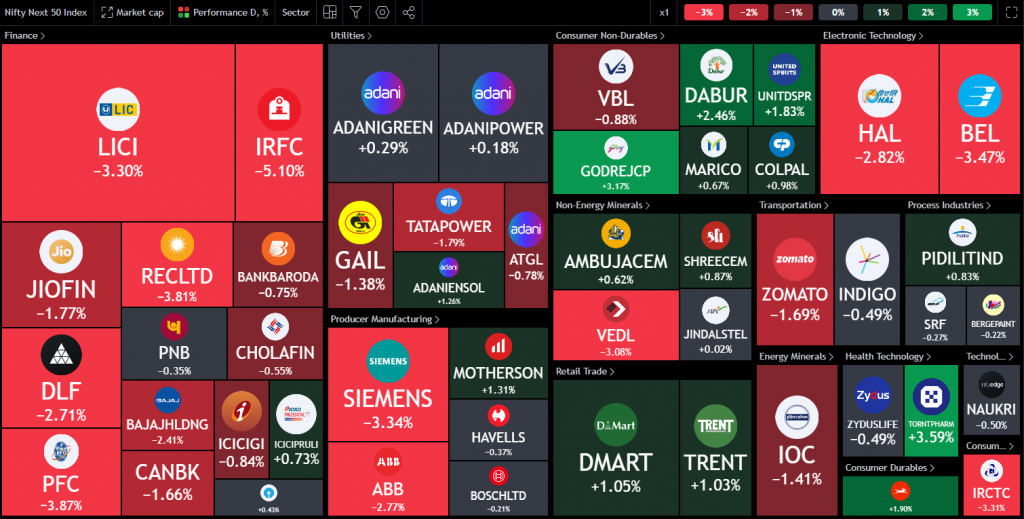
Sectoral Overview
Today you had FMCG on the back of ITC and Levers move up 2.7%. Consumption stocks, Titan, Asian Paints, all these stocks moving up at 1.1%. You had IT move up 0.7%, pharma move of 0.6%. So very, very defensive. Top four sectors. Essentially, the market said that liquidity is going towards defensives, and let’s see how the other parts of the market will recover or whether they will see a deeper dive.
Real estate -2.3% I think is more of a knee jerk reaction on real estate. The indexation on long-term capital gains has been taken off, but my calculation is showing that for most real estate calculations, even people who have bought ten years, 20 years, 30 years back, 12.5% long-term capital gains versus 20% with indexation is still not so bad. I think this knee jerk reaction is there. Of course, this may hit some cash component real estate investing. I think this change of removing indexation and reducing tax is a way in which the government is trying to induce people to do all check transactions. So if, in all, I would say, versus other countries, maybe, or let’s not compare with other countries because that argument comes around that what are we getting for our tax? So even otherwise, 12.5% long-term tax on some asset class is not bad. I mean, if you make some good gains and you’re giving 12.5% of that as tax, I don’t think it is such a bad deal. Especially when you’re giving up to 40% of your personal income as taxation, or 25% of your corporate income as taxation, or 30% with other slabs, 12.5% in asset class, which generates maybe 10 to 12% CAGR, is not so bad.
Public sector banks down 1.4%. Public sector enterprise stocks down 1.4%. A lot of yoyos during the day. I think the recovery in most of these was of many percentage points. For instance, I think during the speech, many of these stocks or sectors had reached -3%, -4% also very good recovery from that point.
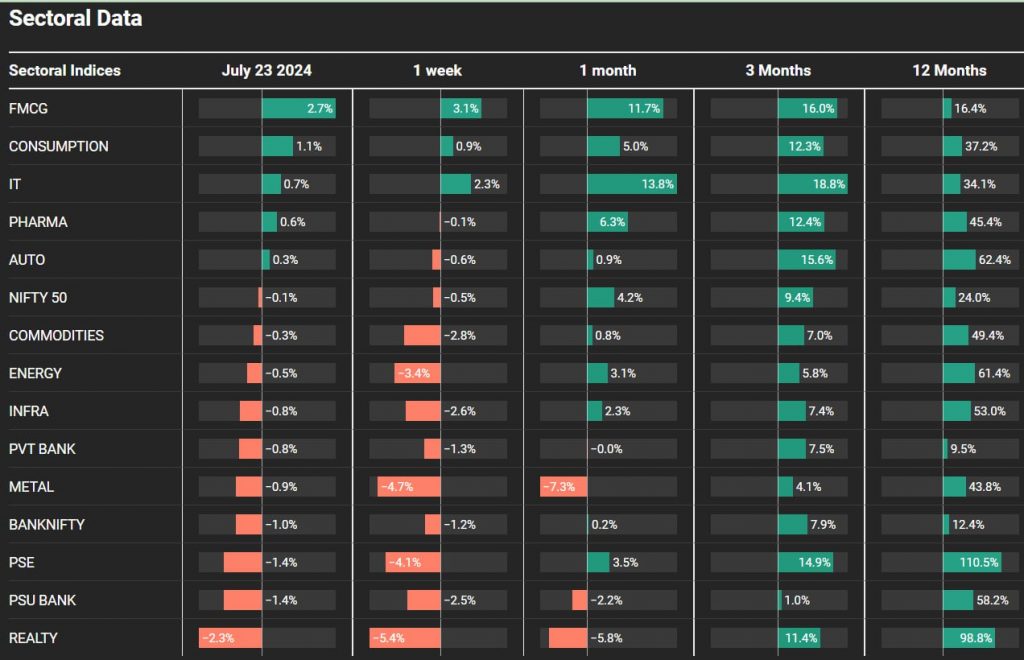
Sectors of the Day
Nifty FMCG Index
FMCG, of course, is just going bonkers since election day. From 53,000, we’ve gone to 63,000. Almost a 20% jump has come around in just seven weeks from the election bottom. Fantastic performance from FMCG. Stocks up 2.6% today.
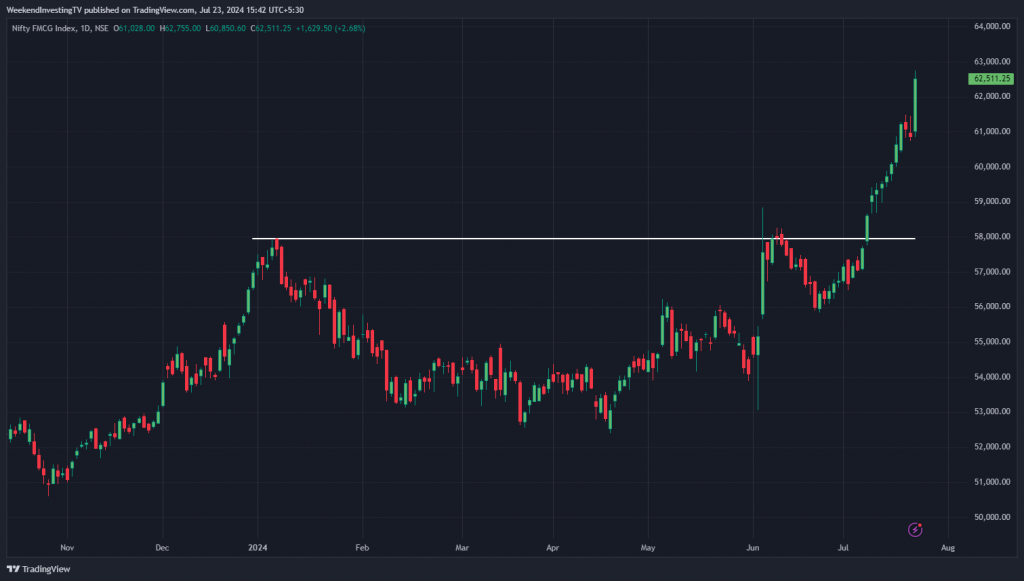
Stocks of the Day
ITC
In terms of stocks, you had ITC move up 5.5%. So ITC is now making a move towards newer highs. It has closed at a new high at 492. If this sustains, I think this can go very, very high. This was a good consolidation for one year. And if this trend has continuation here, it really can have targets much higher.
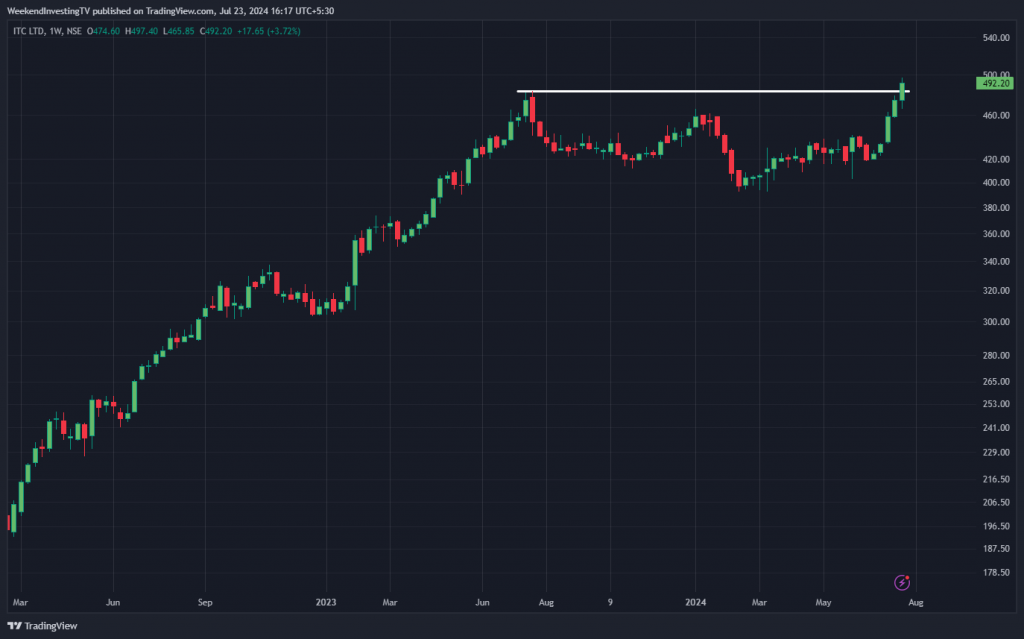
Story of the Day
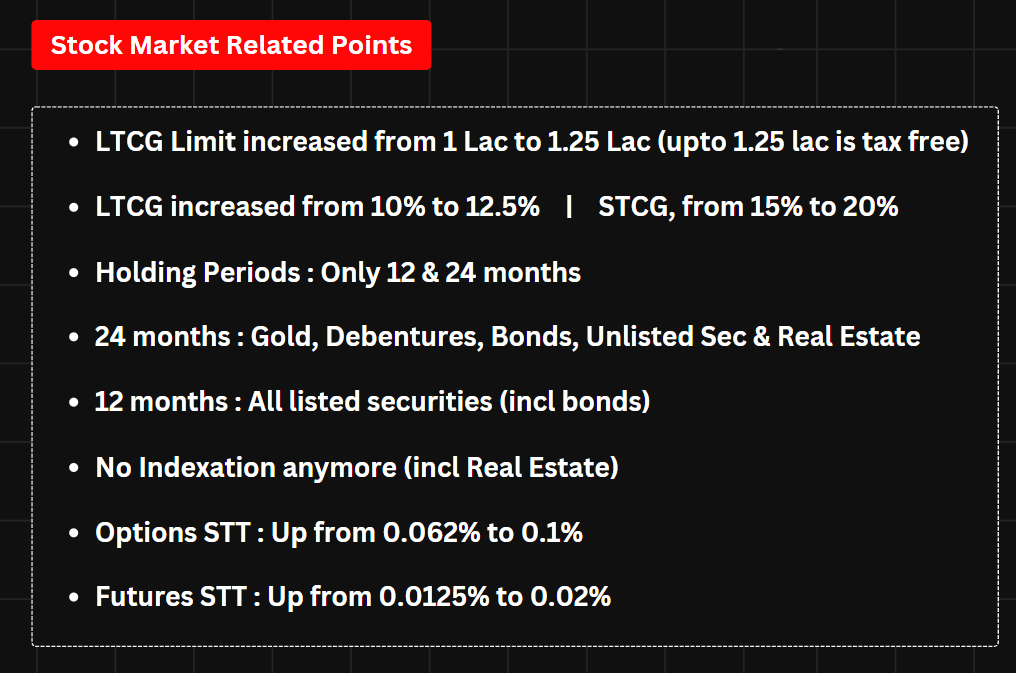
Now let’s come back to the budget tax changes. Terrorism is back.
Key points from the budget:
- The LTCG limit has been increased from one lakh to 1.25 lakhs. While this can help some people, for those who are actively involved in the markets, this amount is not particularly meaningful.
- LTCG has increased from 10% to 12.5%, affecting all asset classes.
- Short-term capital gain tax has increased from 15% to 20%. These are significant jumps, translating to a 25% increase for LTCG and a 33.3% increase for STCG.
- Options STT is up from 0.06 to 0.1, and futures STT has increased from 0.0125 to 0.02. If the intention was to curb participation in options and futures, a better approach might have been to increase the income or net worth criteria for access rather than raising STT by 60%. For example, if someone was paying Rs. 6, they will now pay Rs. 10 as STT. This won’t deter many traders, similar to how warning labels on cigarette packs have not significantly reduced smoking.
These measures are portrayed as beneficial to users, but they primarily increase government revenue. I didn’t particularly like this tinkering with STT. However, one positive aspect is the simplification of the tax regime. Holding periods, which used to be 12 months, 24 months, and 36 months for different asset classes, have now been reduced to two categories: 12 months for all listed securities and bonds, and 24 months for gold, venture bonds, unlisted securities, and REITs.
Regarding real estate, long-term capital gains, which used to be taxed at 20% with indexation, are now taxed at 12.5% without indexation. For example, if you bought a property in 2004 for Rs. 100 and it is now worth Rs. 10,000, you could have indexed the initial Rs. 100 by about four times based on the index calculation and then calculated your capital gains. Now, you pay 12.5% on the entire difference, which can be beneficial for those conducting all-check transactions. For people who conduct white transactions, this makes little difference.
Other changes include:
- Listed debentures and bonds used to be taxed at 10%, now at 12.5%.
- Unlisted debentures and bonds were taxed at 20%, now at 12.5%.
- Units of equity-oriented mutual funds, listed, used to be taxed at 10%, now at 12.5%.
- Units of equity-oriented mutual funds, unlisted, were taxed at 20% with indexation, now at 12.5%.
- REITs and INVITs are now taxed at 12.5%, down from 36 months. This should be 24 months.
Precious metals saw a significant duty reduction from 15% to 6%. This change, while beneficial in the long term for new buyers, has caused a 9% net worth reduction for those who already hold gold. This decrease could have been implemented gradually over several years. The substantial cut may signal a shift in government policy encouraging citizens to buy gold, possibly to reduce dependence on the USD.
Overall, these changes indicate a mix of good and bad for different market participants. The government’s intent seems to be simplifying the tax regime and potentially encouraging gold purchases among citizens, but the increased tax rates and STT changes will have mixed impacts on market behavior.









